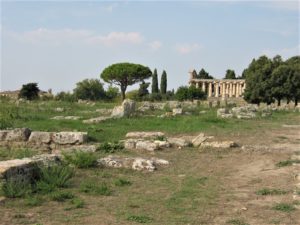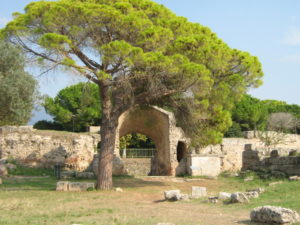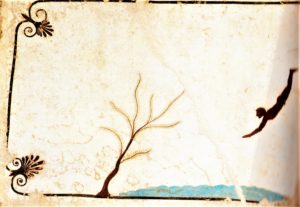During our HF Discovery Holiday to Sorrento in addition to visiting Amalfi, Capri, Herculaneum and Pompei, we also had an organised coach trip to Paestum. It’s about 100 km south of Sorrento but took longer to get there than it should have because there had been a landslip on one of the mountain roads as our route took us via the Amalfi coast and Ravello. Paestum is in the Campania region in the province of Salerno and once we’d skirted round the edge of the city of Salerno the landscape changed completely, from the rocky headlands of the Sorrento peninsular to the flat River Sele Plain, that is now a fertile agricultural area, but was once a malarial swamp. I peered out of the coach window in the hope of seeing some buffaloes as this is the home of buffalo mozzarella; I did see a few in the distance plus lots of roadside kiosks that sell the local cheeses, but which appeared to be closed, probably because it was late in the tourist season. For independent travellers it’s possible to reach Paestum Archaeological Park by train as the railway station is near to the site.
It was a strange feeling arriving at the archaeological park from the north as it seemed to be in the middle of nowhere; not in a town – most of the buildings there have been built because the archaeological site is there – a museum, a few shops and cafes, hotels, restaurants, bars and tourist shops. There were very few visitors – completely different from the hordes at Pompei. We were met by our designated local tour guide, who was not happy that we were (unavoidably) late, her attitude somewhat spoiling the visit. On entering this UNESCO World Heritage Site the first building we came to be the so-called Basilica, or 1st Temple of Hera, which is the oldest and largest of the Greek temples there. I have to admit that I was totally ignorant about this important archaeological site; I knew there were Greek temples on Sicily but I’d never heard of Paestum. It was originally Poseidonia, founded by the Greeks in around 600 BC; eventually it became a Roman colony and was called Paestum, so a lot of the remains are Roman, including a forum, small amphitheatre and baths, although only about a quarter of the site has so far been excavated (the rest of the site is on private land). Next to the Basilica is the 2nd Temple of Hera (or Poseiden or Neptune!) built around 460-450 BC, with the Temple of Athena (circa 500 BC) a short walk away.
Our tickets included admission to the Museum of Archaeology, and we spent some time looking at finds from Paestum itself and also from the Sanctuary of Hera, north of Paestum at the mouth of the River Sele. There are many sculptures, tombs and vases but what I remember distinctly is the Tomb of the Diver – as its walls are covered in frescoes and the top slab has an image of a man diving from a diving board into a sheet of blue water. Sadly we had to leave to return to the hotel in time for dinner but it would have been lovely to have seen the sun setting behind the temples. I think it would be wonderful to stay there for a night or two to experience a sunset and a sunrise over such a magical, atmospheric place.










